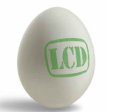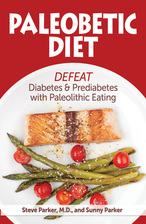Book Review: Paleobetic Diet by Steve Parker, MD
In Paleobetic Diet: Defeat Diabetes and Prediabetes with Paleolithic Eating, Dr. Steve Parker and Sunny Parker provide compelling evidence that it very well could. I’m a big fan of Dr. Parker’s previous book, Conquer Diabetes and Prediabetes: The Diabetic Mediterranean Diet, as well as his website, Diabetic Mediterranean Diet. He’s an expert on the Mediterranean Diet and one of a small but growing number of physicians who recommend a low-carbohydrate diet based on whole foods for people with diabetes and prediabetes. A few years ago he created another website, Paleo Diabetic, covering the beneficial aspects of a carbohydrate-restricted based on paleolithic food principles. Paleobetic Diet is an extension of that website. It’s a very well-written, informative book that’s easy to understand, even for those unfamiliar with paleolithic nutrition or carbohydrate restriction. Dr. Parker’s writing style is professional, low key, and subtly humorous. He’s also very up front about saying “I don’t know” rather than engaging in conjecture or hype, which I really appreciate. His wife Sunny “served primarily as the editor, food maven, recipe mastermind, and Steve’s muse.”
Here are several topics addressed in Paleobetic Diet:
What did people actually eat during the paleolithic era? After introducing us to the modern “Paleo Diet” and a number of people (including doctors and other health professionals with both type 1 and type 2 diabetes) who have experienced health improvements as a result of following it, Dr. Parker discuses the foods that our ancestors subsisted on from roughly 2.5 million to 10,000 years ago, prior to the Agricultural Revolution. During this time the food of our hunter-gatherer ancestors was primarily meat, fish, nuts, roots, grasses, and berries. The omega 3 to omega 6 ratio of polyunsaturated fatty acids was about 1:1 or 1:2 versus 1:10, which is a conservative estimate of what most people currently consume. While the total carbohydrate content was low-moderate (roughly 30-40%, although some sources argue it was somewhat higher), digestible carbohydrate would have been considerably lower given the amount of fiber contained in the plant foods — 70 or more grams, in sharp contrast to our average modern-day consumption of 20 grams or less of total fiber.
Diabetes: There’s an excellent section on the root cause of diabetes and the many complications that can result from long-term uncontrolled blood glucose levels. Dr. Parker stresses that of the three macronutrients (protein, carbohydrates, and fat), carbohydrates have by far the largest impact on blood sugar and insulin levels, and that his own experience with patients who adopt a low-carb diet is congruent with studies demonstrating its effectiveness for diabetes management.
Paleobetic Diet: Dr. Parker’s Paleobetic Diet is based on low-carb ancestral foods like meat (including organ meat), fish, vegetables (primarily nonstarchy), fruit, nuts, and oils. No processed foods, dairy, or artificial sweeteners are allowed. The recommended daily carbohydrate range is 40 to 80 grams of net carbohydrates (total carbohydrates minus all fiber), with advice to aim for a lower carbohydrate amount at breakfast, when insulin resistance is typically the most severe.
There’s a one-week sample meal plan to be used as a guide, along with recipes for each meal that include both imperial and metric measurements. Comprehensive nutritional information is included. The recipes are quick, simple and tasty — much like the kind I prepare on a daily basis. Some of my favorites are the Brian Burger with Bacon, Brussels Sprouts, Tomato, and Pistachios; the Turkey Tomato Bowl; and the Mexican Eggs and Avocado Slices pictured below with accompanying recipe.

Mexican Eggs and Avocado Slices
(1 serving)
Ingredients:
3 large eggs
2 oz (60 g) fresh tomato
3/4 oz (20 g) fresh onion (I used about 1/4 oz)
1/4 jalapeño pepper (I used 1 Tbsp chopped green chiles)
3-4 sprigs fresh cilantro, chopped (I used 1 sprig)
2 tsp olive oil
1 medium California avocado
salt and pepper, to taste
Preparation:
Make the pico de gallo first: Finely chop and mix together the tomato, onion, jalapeño pepper, cilantro, salt, and pepper.
Peel and slice the avocado. Add salt and pepper, to taste.
Fry the eggs in a pan coated with olive oil. Salt and pepper as desired. When done, transfer to a plate and spoon the pico de gallo onto the eggs. Enjoy with avocado slices on the side.
Nutritional Analysis:
72% fat
13% carbohydrate
15% protein
592 calories
20.5 grams carbohydrate
13 grams fiber
7.5 grams digestible carbohydrate
47 grams fat
22 grams protein
810 mg sodium (assuming 1/4 teaspoon total is used)
1235 mg potassium
Diabetes Medications: One of Dr. Parker’s goals is to help reduce the amount of medication needed to achieve optimal blood sugar control. In addition to a detailed plan for successful implementation of the Paleobetic Diet, he provides a section about all 12 classes of diabetes medications that includes their benefits, risks, and whether they have potential to cause hypoglycemia. He stresses the importance of speaking with a healthcare provider (doctor, nurse practitioner, or diabetes educator) prior to making dietary changes for those currently taking insulin or oral diabetes medications.
Paleo Eating Tips: I really enjoyed the “Daily Life with Paleo Eating” chapter, which contains guidance on shopping, cooking, cravings for sweets and other high-carbohydrate foods, and weight loss. There’s also a substantial list of online resources for low-carb Paleo recipes, nutrition analysis, and support. Despite the overall simplicity that characterizes a Paleo way of eating, there are still adjustments that will likely need to be made, based on each person’s particular circumstances, and this chapter is very helpful in that regard.
Exercise: Dr. Parker did a great job on the exercise section, including a subtitle declaring “Exercise Is Not Fun.” (Did I mention how much I appreciate his wry sense of humor?) He gives practical tips for choosing activities that you’ll stick with that provide health-related benefits. Again, he stresses consulting with your physician to obtain medical clearance before engaging in an exercise program.
Research: Here he explains that while there isn’t a great deal of research on the paleolithic diet, what exists is quite promising for those looking to lose weight and improve blood glucose control and overall health. In addition to citing references, he provides detailed analyses of several studies, along with his own commentary on the results and suggestions for further research. In the final chapter, Dr. Parker discusses new theories about the cause of type 2 diabetes, which I found very interesting. There’s considerable disagreement among the experts on this topic, and I appreciate the opportunity to hear from all sides.
Paleobetic Diet provides a great framework for people with diabetes and prediabetes interested in a paleolithic-inspired way of eating. While my own diet is much closer to the one Dr. Parker recommends in The Diabetic Mediterranean Diet (for one thing, I enjoy at least one serving of dairy every day, often more), I understand the potential benefits for people with autoimmune disease or food intolerances. I like his guideline of aiming for 15-20 grams of net carbohydrate per meal, and using a glucometer to assess whether further reduction in carbs is necessary to optimize blood sugar control. He’s done a wonderful job summarizing the research on paleolithic diets and constructing his own plan to help people achieve a healthier lifestyle with a decreased risk for complications.
While much of the information contained in the book is available on the Paleo Diabetic website (in fact, the book has links to certain documents that can be downloaded directly from the site at no charge), I highly recommend purchasing the print or Kindle version of Paleobetic Diet for the additional material covered. I’d also encourage you to support the efforts of this low-carbohydrate MD who provides free, high-quality, well-researched informative content on his websites.


Thanks for another book review. With many books on the subject, it’s wonderful having guidance on those that are worthwhile. Dr. Parker’s website is great.
Thanks for your comments, Geri!